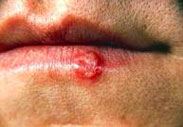Contents
What is HSV-1?
 Cold sores are caused by a virus called herpes (pronounced hur-peez). Herpes outbreaks are one of the most common viral infections in the world. The medical name for the specific virus that causes cold sores is Herpes Simplex.
Cold sores are caused by a virus called herpes (pronounced hur-peez). Herpes outbreaks are one of the most common viral infections in the world. The medical name for the specific virus that causes cold sores is Herpes Simplex.
Herpes simplex (HSV-1) is also commonly referred to as cold sores, fever blisters, oral herpes or herpes labialis. It is a viral infection of the skin that may occur once or return again and again.
This happens when the virus is cleared from the skin by the immune system, it then hides in the nerves and is never completely removed from the body. Herpes outbreak infections are very common. It is estimated that nine out of ten people have been exposed to herpes outbreaks and many of these don’t even know they have it. Those who carry herpes can spread the disease without even knowing it.
Herpes simplex begins as a group of small red bumps that blister and preceded by itching and burning of the area. The blisters begin to dry up after a few days and form a yellow crust. The crust then falls off and the redness slowly goes away. The whole process takes about 10-14 days. Scars rarely form.
What causes Herpes Simplex Virus-1?
- Cold sores are generally contracted from skin to skin contact with an infected area.
- People can catch HSV-1 by sexual contact such as kissing a person with a cold sore or sharing a drinking glass or utensils.
- Family members should not share towels or linen with someone who has an outbreak of herpes on the genitalia or cold sores. Herpes outbreaks can spread from person to person even when an infected individual has no outbreak or symptoms.
- Once infected with cold sores, the virus remains inside the body in a latent (sleeping) state. Throughout a person’s life the virus can then become “activated” causing a cold sore recurrence.
What are some of the symptoms of a Cold sores or fever blisters?
- Before a cold sore appears, the area will sometimes tingle, feel slightly raised and may appear red and inflamed. This pain or tingling sensation (prodrome – warning symptom) typically occurs 1 to 2 days before the cold sore appears.
- A cold sore generally appears as a small, fluid-filled blister. The blister will usually weep (ulcerate) and form a scab or ‘crusting’ before healing and disappearing completely.
- The duration of a typical cold sore outbreak may last from 8 to 14 days.
What causes or “activates” a Cold sores or fever blisters recurrence?
If you’ve had cold sores before, it can be hard to tell what might make them come back. Below are some factors that may trigger it to return:
- Stress
- Sun (Exposure of the area to strong sunlight)
- Incorrect diet
- Fever
- Menstruation Cycle
- Fatigue (not getting enough rest)
- Being run-down
- Pregnancy
- Drinking a lot of alcohol
- Ultraviolet light
- Skin irritation (such as sunburn)
- Certain foods
- Temperature extremes
Treatment
Cold sores and fever blisters can be the most embarrassing outbreak one can get, because they are exposed for everyone to see. People with oral (cold sores) outbreaks often refrain from going out and will stay indoors till the symptoms disappear.
